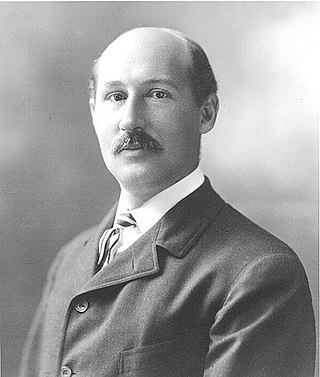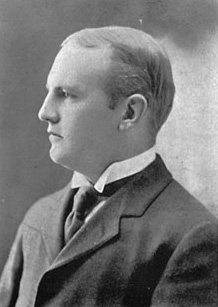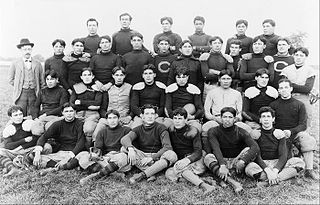
College football refers to gridiron football played by teams of student athletes. It was through college football play that American football rules first gained popularity in the United States.

Walter Chauncey Camp was an American college football player and coach, and sports writer known as the "Father of American Football". Among a long list of inventions, he created the sport's line of scrimmage and the system of downs. With John Heisman, Amos Alonzo Stagg, Pop Warner, Fielding H. Yost, and George Halas, Camp was one of the most accomplished persons in the early history of American football. He attended Yale College, where he played and coached college football. Camp's Yale teams of 1888, 1891, and 1892 have been recognized as national champions. Camp was inducted into the College Football Hall of Fame as a coach during 1951.

Ernest Alonzo Nevers, sometimes known by the nickname "Big Dog", was an American football and baseball player and football coach. Widely regarded as one of the best football players in the first half of the 20th century, he played as a fullback and was a triple-threat man known for his talents in running, passing, and kicking. He was inducted with the inaugural classes of inductees into both the College Football Hall of Fame in 1951 and the Pro Football Hall of Fame in 1963. He was also named in 1969 to the NFL 1920s All-Decade Team.

The Stanford Cardinal football program represents Stanford University in college football at the NCAA Division I FBS level and is a member of the Pac-12 Conference's North Division. The team is known as the Cardinal, adopted prior to the 1982 season. Stanford was known as the "Cardinal" for its first two decades of athletic competition, then more commonly as the "Cardinals" until 1930. The name was changed to the "Indians" from 1930 to January 1972, and back to the "Cardinals" from 1972 through 1981. A student vote in December 1975 to change the nickname to "Robber Barons" was not approved by administrators.

Clifford Douglas "Pop" Bliss was an American college football player and coach. He served as the head football coach at Stanford University, Haverford College, and the University of Missouri, compiling a career coaching record of 15–6–1. Bliss played football at Yale University as a halfback alongside his brother, Laurie Bliss, who went on to coach at the United States Military Academy and Lehigh University.
The 1947 Stanford Indians football team was an American football team that represented Stanford University in the Pacific Coast Conference (PCC) during the 1947 college football season. In its third year under head coach Marchmont Schwartz, the team compiled a 0–9 record, finished last in the PCC, and was outscored by a total of 214 to 73.

The 1891 Stanford football team represented Stanford University in the 1891 college football season. This was the inaugural year of both the University and the football team: the University opened in October 1891 and the four-game season was played in early 1892.
The 1901 Stanford football team was an American football team that represented Stanford University as an independent during the 1901 college football season. The team was led by Charles Fickert, the first former Stanford player to serve as head football coach at his alma mater. The team played its home games at Stanford, California.
The 1925 Stanford football team was an American football team that represented Stanford University as a member of the Pacific Coast Conference (PCC) during the 1925 PCC football season. In its second season under head coach Pop Warner, Stanford compiled a 7–2 record and finished second in the PCC. Its only conference loss was against conference champion Washington. The team played its home games at Stanford Stadium in Stanford, California. The team was ranked No. 8 in the nation in the Dickinson System ratings released in January 1926.

The 1892 Yale Bulldogs football team represented Yale University in the 1892 college football season. In its fifth and final season under head coach Walter Camp, the team finished with a 13–0 record and outscored opponents by a total of 429 to 0. Mike Murphy was the team's trainer. The team is regarded as the 1892 national champion, having been selected retrospectively as such by the Billingsley Report, Helms Athletic Foundation, Houlgate System, National Championship Foundation, and Parke H. Davis. Yale's 1892 season was part of a 37-game winning streak that began with the final game of the 1890 season and stopped at the end of the 1893 season.

The 1893 Stanford football team represented Stanford University in the 1893 college football season. Led by C. D. Bliss, Stanford was undefeated, with one tie against rival California.

The 1892 Stanford football team represented Stanford University in the 1892 college football season and was coached by Walter Camp.
The 1900 Stanford Cardinal football team represented Stanford University in the 1900 college football season. In their first and only season under head coach Fielding H. Yost, the team compiled a 7–2 record, shut out seven of nine opponents, scored 154 points, and allowed 20 points by opponents. The team registered three shutouts against the Reliance Club, two shutouts against California State Normal School, now known as San Jose State University, and single game shutouts against Oregon and California. The team's two losses came against Nevada (0–6) and a Stanford alumni team (0–14) that featured coach Yost playing at the fullback position.
The 1919 Stanford football team represented Stanford University in the 1919 college football season.

The 1899 Carlisle Indians football team represented the Carlisle Indian Industrial School as an independent during the 1899 college football season. Led by first-year head coach Pop Warner, the Indians compiled a record of 9–2 and outscored opponents 383 to 46.
The 1894 Chicago vs. Stanford football game, played on December 25, 1894 was a college football game between the Chicago Maroons and Stanford. Chicago won 24 to 4. The game was played in San Francisco, California. It was the first postseason intersectional contest, foreshadowing the modern bowl game. Herbert Hoover was Stanford's student financial manager.

The early history of American football can be traced to early versions of rugby football and association football. Both games have their origin in varieties of football played in Britain in the mid–19th century, in which a football is kicked at a goal or run over a line, which in turn were based on the varieties of English public school football games.
The 1892 Penn Quakers football team represented the University of Pennsylvania in the 1892 college football season. The Quakers finished with a 15–1 record in their first year under head coach and College Football Hall of Fame inductee, George Washington Woodruff. Significant games included victories over Penn State (20–0), Navy (16–0), Lafayette, and Princeton (6–4), and its sole loss to undefeated national champion Yale (28–0). The 1892 Penn team outscored its opponents by a combined total of 405 to 52. Penn halfback Harry Thayer was selected by both Walter Camp and Caspar Whitney as a first-team player on the 1892 College Football All-America Team.
The 1899 California Golden Bears football team was an American football team that represented the University of California, Berkeley during the 1899 college football season. The team competed as an independent under head coach Garrett Cochran and compiled a record of 7–1–1.
The 1901 California Golden Bears football team was an American football team that represented the University of California as an independent during the 1901 college football season. In its first season under head coach Frank W. Simpson, the team compiled a 9–0–1 record and outscored opponents by a total of 106 to 15.











